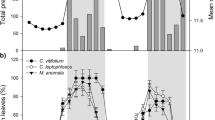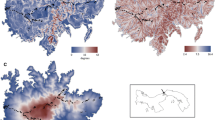Abstract
Treefall gaps in tropical forests have a profound effect on plants growing in the understory, primarily due to increased light availability. In higher light, mature leaves typically have increased anti-herbivore defenses. However, since the majority of herbivory occurs while leaves are expanding, it is important to determine whether defense expression during the short period of leaf expansion is canalized (invariant) or plastic in response to variation in light. Therefore, we examined young leaves of Inga paraensis (Fabaceae) saplings growing along a light gradient in a terra-firme forest in Central Amazonia. We quantified leaf production and expansion time, dry mass of phenolics, saponins, and nitrogen, ants attracted to extrafloral nectaries, and leaf consumption. Over the entire light gradient, the number of leaves produced per flush increased by 50 % and the mass of phenolic compounds by 20 %, but no other traits changed. On average, 39 % of leaf area was consumed with no difference across the light gradient. Alone, none of the leaf traits was a significant predictor of leaf consumption, except for phenolics, which showed a positive relationship. Multiple regressions showed that leaf consumption was positively related to more leaves per flush and a higher concentration of phenolics in leaves. Unlike studies of mature leaves, young leaves of I. paraensis show low plasticity in defense traits across a light gradient, suggesting that leaf development is canalized.


Similar content being viewed by others
References
Aide TM (1993) Patterns of leaf development and herbivory in a tropical understory community. Ecology 74:455–466. doi:10.2307/1939307
Aide TM, Londoño EC (1989) The effects of rapid leaf expansion on the growth and survivorship of a lepidopteran herbivore. Oikos 55:66–70. doi:10.2307/3565873
Baraza E, Gómez JM, Hódar JA, Zamora R (2004) Herbivory has a greater impact in shade than in sun: response of Quercus pyrenaica seedlings to multifactorial environmental variation. Can J Bot 82:357–364. doi:10.1139/B04-004
Bierregaard RO, Gascon C (2001) The biological dynamics of forest fragments project: the study site, experimental design, and research activity. In: Bierregaard RO, Gascon C, Lovejoy TE, Mesquita R (eds) Lessons from Amazonia: the ecology and conservation of a fragmented forest. Yale University Press, Michigan, pp 31–42
Bixenmann RJ (2011) Induced responses and developmental changes of direct and indirect defenses in the young leaves of the Neotropical tree genus Inga. PhD dissertation. University of Utah, Salt Lake City
Bixenmann RJ, Coley PD, Kursar TA (2011) Is extrafloral nectar production induced by herbivores or ants in a tropical facultative ant-plant mutualism? Oecologia 165:417–425. doi:10.1007/s00442-010-1787-x
Brenes-Arguedas T, Horton MW, Coley PD, Lokvam J, Waddell RA, Meizoso-O’Meara BE, Kursar TA (2006) Contrasting mechanisms of secondary metabolite accumulation during leaf development in two tropical tree species with different leaf expansion strategies. Oecologia 149:91–100. doi:10.1007/s00442-006-0423-2
Bryant JP, Chapin FS III, Klein DR (1983) Carbon/nutrient balance of boreal plants in relation to vertebrate herbivory. Oikos 40:357–368. doi:10.2307/3544308
Chacón P, Armesto JJ (2006) Do carbon-based defences reduce foliar damage? Habitat-related effects on tree seedling performance in a temperate rainforest of Chiloé Island, Chile. Oecologia 146:555–565. doi:10.1007/s00442-005-0244-8
Chazdon RL (1992) Photosynthetic plasticity of two rain forest shrubs across natural gap transects. Oecologia 92:586–595. doi:10.1007/BF00317853
Chazdon RL, Fetcher N (1984) Photosynthetic light environments in a lowland tropical rain forest in Costa Rica. J Ecol 72:553–564. doi:10.2307/2260066
Coley PD, Barone JA (1996) Herbivory and plant defenses in tropical forests. Annu Rev Ecol Syst 27:305–335. doi:10.1146/annurev.ecolsys.27.1.305
Eichhorn MP, Compton SG, Hartley SE (2006) Seedlings species determines rates of leaf herbivory in a Malaysian rain forest. J Trop Ecol 22:513–519. doi:10.1017/S026646740600335X
Folgarait PJ, Davidson DW (1994) Antiherbivore defenses of myrmecophytic Cecropia under different light regimes. Oikos 71:305–320. doi:10.2307/3546279
Frazer GW, Canham CD, Lertzman KP (2000) Gap light analyzer (GLA), version 2.0: technological tools. Bull Ecol Soc Am 81:191–197
Frazer GW, Richard RA, Trofymow JA, Hall RJ (2001) A comparison of digital and film fisheye photography for analysis of forest canopy structure and gap light transmission. Agric For Meteorol 109:249–263. doi:10.1016/S0168-1923(01)00274-X
Givnish TJ (1988) Adaptation to sun and shade: a whole-plant perspective. Aust J Plant Physiol 15:63–92
Henriksson J, Haukioja E, Ossipov V, Ossipova S, Sillanpää S, Kapari L, Pihlaja K (2003) Effects of host shading on consumption and growth of the geometrid Epirrita autumnata: interactive roles of water, primary and secondary compounds. Oikos 103:3–16. doi:10.1034/j.1600-0706.2003.12306.x
Howlett BE, Davidson DW (2001) Herbivory on planted dipterocarp seedlings in secondary logged forests and primary forests of Sabah, Malaysia. J Trop Ecol 67:283–335. doi:10.1017/S0266467401001195
Kersch MF, Fonseca CR (2005) Abiotic factors and the conditional outcome of an ant-plant mutualism. Ecology 86:2117–2126. doi:10.1890/04-1916
Koptur S (1984) Experimental evidence for defense of Inga (Mimosoideae) saplings by ants. Ecology 65:1787–1793. doi:10.2307/1937775
Koricheva J, Larsson S, Haukioja E, Keinanen M (1998) Regulation of woody plant secondary metabolism by resource availability: hypothesis testing by means of meta-analysis. Oikos 83:212–226. doi:10.2307/3546833
Kursar TA, Coley PD (1991) Nitrogen content and expansion rate of young leaves of rain forest species: implications for herbivory. Biotropica 23:141–150. doi:10.2307/2388299
Kursar TA, Coley PD (1992) The consequences of delayed greening during leaf development for light absorption and light use efficiency. Plant Cell Environ 15:901–909. doi:10.1111/j.1365-3040.1992.tb01022.x
Kursar TA, Coley PD (2003) Convergence in defense syndromes of young leaves in tropical rainforests. Biochem Syst Ecol 31:929–949. doi:10.1016/S0305-1978(03)00087-5
Kursar TA, Wolfe BT, Epps MJ, Coley PD (2006) Food quality, competition, and parasitism influence feeding preference in a Neotropical lepidopteran. Ecology 87:3058–3069. doi:10.1890/0012-9658(2006)87[3058:FQCAPI]2.0.CO;2
Lierberman D, Lieberman M (1984) The causes and consequences of synchronous flushing in a dry tropical forest. Biotropica 16:193–201. doi:10.2307/2388052
Lima AJN, Teixeira LM, Carneiro VMC, dos Santos J, Higuchi N (2007) Biomass stock and structural analysis of a secondary forest in Manaus (AM) region, ten years after clear cutting followed by fire. Acta Amazon 37:49–54
Lokvam J, Kursar TA (2005) Divergence in structure and activity of phenolic defenses in young leaves of two co-occurring Inga species. J Chem Ecol 31:2563–2580. doi:10.1007/s10886-005-7614-x
Mattson WJ Jr (1980) Herbivory in relation to plant nitrogen content. Annu Rev Ecol Syst 11:119–161
McKey D, Waterman PG, Mbi CN, Gartlan JS, Struhsaker TT (1978) Phenolics content of vegetation in two African rain forests: ecological implications. Science 202:61–64
Mole S, Ross JAM, Waterman PG (1988) Light-induced variation in phenolics levels in foliage of rain-forest plants I. Chemical changes. J Chem Ecol 14:1–22. doi:10.1007/BF01022527
Moles AT, Westoby M (2000) Do small leaves expand faster than large leaves and do shorter expansion times reduce herbivory damage? Oikos 90:517–524. doi:10.1034/j.1600-0706.2000.900310.x
Nichols-Orians CM (1991) The effects of light on foliar chemistry, growth and susceptibility of seedlings of a canopy tree to an attine ant. Oecologia 86:552–560. doi:10.1007/BF00318322
Pennington TD (1997) The genus Inga: botany. Kew, London
Poorter H, Niinemets Ü, Poorter L, Wright IJ, Villar R (2009) Causes and consequences of variation in leaf mass per area (LMA): a meta-analysis. New Phytol 182:565–588. doi:10.1111/j.1469-8137.2009.02830.x
Potter DA, Kimmerer TW (1989) Inhibition of herbivory on young holly leaves: evidence for the defensive role of saponins. Oecologia 78:322–329. doi:10.1007/BF00379105
R Development Core Team (2009) R: a language and environment for statistical computing. URL http://www.R-project.org. Accessed 10 Apr 2012
Rich PM, Clark DB, Clark DA, Oberbauer SF (1993) Long-term study of solar radiation regimes in a tropical wet forest using quantum sensors and hemispherical photography. Agric For Meteorol 65:107–127
Richards LA, Coley PD (2007) Seasonal and habitat differences affect the impact of food and predation on herbivores: a comparison between gaps and understory of a tropical forest. Oikos 116:31–40. doi:10.1111/j.2006.0030-1299.15043.x
Siegal ML, Bergman A (2002) Waddington’s canalization revisited: developmental stability and evolution. Proc Natl Acad Sci USA 99:10528–10532. doi:10.1073/pnas.102303999
Sipura M, Tahvanainen J (2000) Shading enhances the quality of willow leaves to leaf beetles: but does it matter? Oikos 91:550–558. doi:10.1034/j.1600-0706.2000.910317.x
Valladares F, Wright SJ, Lasso E, Kitajima K, Pearcy RW (2000) Plastic phenotypic response to light of 16 congeneric shrubs from a Panamanian rainforest. Ecology 81:1925–1936. doi:10.1890/0012-9658(2000)081[1925:PPRTLO]2.0.CO;2
Acknowledgments
GS appreciates help with field and lab work from P.H.S. Soares, C. Brancolina, E.R. Araújo, L.S. Chalco, E.Z. de Albuquerque, M.C. Vaz; M.T.B. da Silva, J.B. da Silva, J.F.T. Junior, S. Khachaturyan, R. Bixenmann, D. Denney, E. Murakami. We acknowledge valuable logistical support from BDFFP/INPA in Manaus, AM, Brazil; we thank J.M. da S Vilhena for identifying the ants; J. Seger and F. Adler for enlightenment regarding statistics; C. Dambros and E. Spear for R programming assistance, B. Lenz, C. Emer, K. Kitajima and anonymous reviewers for thoughtful comments on the manuscript. Field collections were conducted in Manaus, Brazil and complied with current state and federal laws. Plants were exported through permit number 107895 from the Instituto Brasileiro do Meio Ambiente e dos Recursos Naturais Renováveis. G.S. received a Master scholarship and M.R.L. a research fellowship from the Brazilian’s Conselho Nacional de Desenvolvimento Científico e Tecnológico. T.A.K., P.D.C., and J.L. were supported by National Science Foundation Grants DEB-0234936, DEB-0640630, DEB-1135733 and Research Experience for Undergraduate supplements. This is publication number 592 in the Biological Dynamics Forest Fragments Project Technical Series.
Author information
Authors and Affiliations
Corresponding author
Additional information
Communicated by Alice Winn.
Electronic supplementary material
Below is the link to the electronic supplementary material.
Rights and permissions
About this article
Cite this article
Sinimbu, G., Coley, P.D., Lemes, M.R. et al. Do the antiherbivore traits of expanding leaves in the Neotropical tree Inga paraensis (Fabaceae) vary with light availability?. Oecologia 170, 669–676 (2012). https://doi.org/10.1007/s00442-012-2353-5
Received:
Accepted:
Published:
Issue Date:
DOI: https://doi.org/10.1007/s00442-012-2353-5




